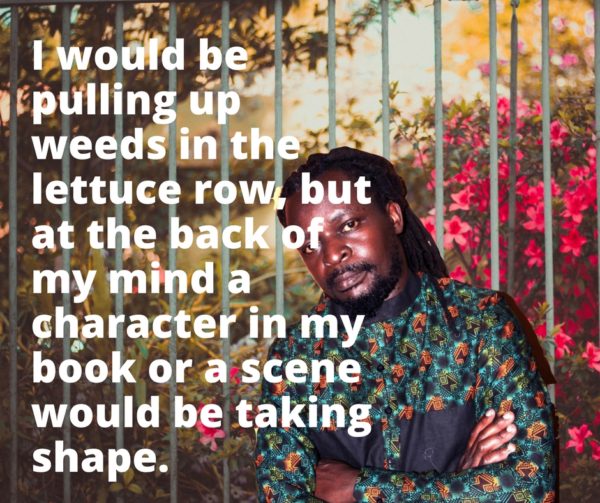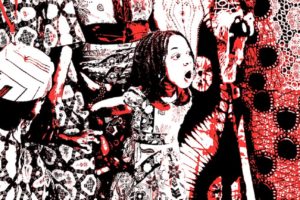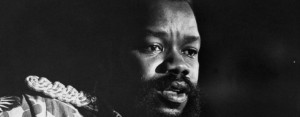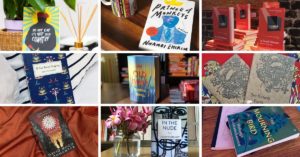Vegetables are generally underrated food items. They are not as fun and flavorful as other culinary favorites like meats and grains. And we sure wouldn’t peg them for being inspirational. But not so for Kenyan writer Gazemba. In a beautiful and detailed account of his journey to becoming a debut novelist, Gazemba reveals that the big idea for his novel came to him in a garden.
At the time, he worked as a gardener in a colonial bungalow in Nairobi, “turning the sodden manure” and “raking the leaves off the lawns.” And somewhere between fennel bulbs and tomatoes, kales and swiss chard, carrots and radishes, the spark for the new novel came to him. As he pulled up weed in the lettuce row, he let the characters and plot details take shape at the back of his mind.
To start with, it is fitting that a novel titled Forbidden Fruit is conceived in a garden. But like everything that happens in a garden—a first kiss or Eve getting Adam to eat the forbidden fruit—what follows is an arduous journey of hard work and commitment. For Gazemba, what followed was a long journey that involved scribbling on school-type notebooks for three weeks and, later on, beating out a manuscript on a classic Olivetti manual typewriter. Rejection slips came in. But Gazemba persevered. A small Nairobi press eventually picked up the book. He subsequently won an award for the book. Today the novel, which was originally published in Nairobi is now getting a US reissue.
A truly inspiring story!
If you’re interested in Gazemba’s inspiring journey from gardening to writing, see the excerpt below. Click HERE to order Gazemba’s novel.
***
The idea for Forbidden Fruit came to me in the expansive garden of an old colonial bungalow in Nairobi’s Lavington Estate, where I was then working as a gardener. Although the book was first published in Kenya in 2002 as The Stone Hills of Maragoli, it reverted to its working title when it was reissued by my American publisher, The Mantle, in 2017. We were in the middle of our Nairobi “winter,” around June or July. Back then the seasons were fairly regular and predictable, before the Global Warming monster came upon us. During our winter then, the temperatures dropped to levels where you could hardly hear the birds chirping up in the trees, the mist driving in steadily from the coffee estates to the northwest of the city: Limuru and Kabeteshire.
If there happened to be a heavy downpour before the chill set in, working in the garden became a nightmare. The vegetables grew monstrous. The kales and Swiss chard sprang out of the dark earth and tottered on their thin legs, their oversize leaves fanning out in the chill like elephant ears. The carrots and radishes pushed deeper into the sodden soil, the tubers splitting into finger-like stubs that were difficult to pull out. The fennel bulbs fattened into elephantine proportions, the tomatoes rotting on the vines in the damp. Nothing was sweet in the garden. The only thing that didn’t seem to mind the weather was the little banana grove at the corner of the garden, which thrived.
As I worked in this garden, turning the sodden manure or raking the leaves off the lawns, I would be thinking about my story. A reader once asked me how I compose my stories and I told her that it is a huge mystery that mostly happens in the subconscious when I am doing other things; the nether realms of our brain where formless things reside. It is exactly what was happening to Forbidden Fruit. I would be pulling up weeds in the lettuce row but at the back of my mind a character in my book or a scene would be taking shape, the plot, which I already roughly knew where it was headed, unfolding.
How the Characters Took Shape
At some point in my teens when I was starting to write I used to keep a small notebook, what you might call a scrapbook of my ideas. It was small enough to slip into a back pocket or a shoulder bag, and hard-covered, the sort small corner store owners keep by the till to record the details of their creditors in. I kept it for quite a while, but, gradually, as I grew older, I realized it was going to make me crazy. Otherwise how do you explain someone springing up in the deep of night, turning on the light, and proceeding to scribble down an idea furiously in compact coded script that is legible only to him for a straight and intense fifteen minutes or so, before calmly putting out the light and going back to sleep? Sometimes the urge would happen in the middle of a busy street. I realized that it was sheer madness, and so I stopped. Painfully so, more like a cigarette smoker trying to quit overnight; or a limbless man forcing himself not to scratch the stub.
And it is not that the gremlins went away; just that they stopped to dictate what I did with them when they came. Gradually I trained myself to file away the idea in my mind and mull over it, kind of give it time to simmer, reminding myself that if it was good enough then it wouldn’t disappear, but come back in a more coherent and ripened form with the dawn. If it wasn’t worth the effort then it would, well, disappear.
It is in this mysterious way that the story and characters of Forbidden Fruittook shape, without a note being written anywhere. I knew exactly where I was placing this story: in the Christmas-time of my childhood, in the village in which I used to spend three months of the year as a boy when I was not away at boarding school. The characters were coming from this childhood village, what they would do were the things I used to observe in this childhood village. The only thing I would do was dictate the way in which those things would be done in the story, which was a figment of my own imagination. I would also tweak their personalities such that they became my own creations, and not real people that I knew. Further still, I would create my own village out of that childhood village.
August was my leave, so I collected my pay and decided to travel upcountry briefly to visit my family in the village. By this time the story was clearly abuzz in my head. I guess what I was doing, as I walked the paths of that village in the evenings, was to put the final touches to the village I had created in my mind, position a thatched hut here, move a fork in the path there, and so on. After a few days I came back to Nairobi and lodged with my elder brother in Nairobi’s Eastlands. I bought a couple of school-type notebooks and Bic pens and sat down to write in the old-fashioned way. For the next three weeks or so the story took complete control of me, the story-genie possessing me body and soul. The blue Bic scrawl danced on the white sheets, filling the ruled pages like a paintbrush working its way down a blank canvas. It was so effortless, so joyous, so challenging, so fulfilling… and so mentally exhausting. All I did in the evenings was walk to the pub at the corner, order a beer, and sit there staring at the TV screen behind the bar blankly like a zombie, talking to no one, recharging my batteries for the next phase.
Writing in the Rain
The following month is when I sat down to type. I was back at my workplace in Lavington, and although the winter months had passed, the winter itself hadn’t lifted. Instead it had transmogrified into another monster. The grey skies had decided to open up and the rains had decided to pound Nairobi. It was a crazy kind of rain, a demon rain. It would start at around 3:00 pm, just when people were preparing to leave the office. In just half an hour of steady sheeting the city’s streets would be flooded, the traffic as the office workers tried to escape in a panic completely gridlocked. Within an hour the streets would resemble Noah’s town, the wheels of the vehicles completely submerged, the motorists working their cellphones idly behind their misted-over windows that only rolled down briefly for an insult to fly out at the idiot trying to nose their way into the lane up ahead.
The steady downpour tested tempers to the limit, grated on already frayed nerves till everyone thought it could never get worse. And it didn’t abate, going on steadily the whole night, only pausing briefly once in a while before resuming with a vengeance. It would carry on until the following morning at around 9:00 after everyone had dragged themselves back to work. It was a demon rain.
It was during these chilly nights that I would be laboring away at the classic Olivetti manual typewriter that I had been gifted by my boss when she learned I was a writer, and on which I had taught myself to type in a crude fashion that is not taught in any typing class, with my two middle fingers mostly laboring away on the smooth rounded keys, the left hand releasing and banging back the carriage return and right thumb and forefinger twirling the platen knob to the next line.
As the sleet pattered on the misted glass of the window, I would be swaddled in sweaters, my feet encased in two pairs of socks, the ashes in the charcoal brazier in the corner that I had earlier lit to warm the room long gone cold. In the stillness of the night the hammering of the metal keys on the drum was sweet music that kept me company. The rhythm would only be interrupted when the lights suddenly went out without warning—another Kenya Power substation nearby that had gotten marooned in the floods and had to be shut down—and in the interval I would turn up the wick of my kerosene lantern that was on standby, take a sip of the by-then lukewarm coffee from the Chinese Thermos at my elbow, and then resume my love affair with my demanding mistress.
I had expected that the day I typed the final full stop in the document I would experience an outpouring of something, a kind of catharsis. I didn’t. Instead I slumped back in my chair, linked my hands over my eyes and let my breath out very slowly. For the few weeks that I had banged away at that Olivetti I had strained to remember my grammar. It irritated me a lot when I had to white-out a word toward the bottom of an otherwise beautifully constructed page simply because I had gotten the spelling wrong. Back then the craft was demanding, and we simply didn’t have the luxury of a second take that computers brought.
The first publisher I showed the book to promptly killed the euphoria and momentum that had built up toward the last weeks of completing the project. While East African Educational Publishers had promised that they would get back to me with a publishing decision in two weeks, the weeks slowly dragged into months, and it slowly started to dawn on me that perhaps I hadn’t written a masterpiece, after all. After half a dozen or so follow-up phone calls to the publisher I gradually pushed the manuscript to the back of my mind and started working on another project. It is this agonizing silence in which the writer has no idea what is going on with the gate-keepers in the publishing industry that I was quickly going to learn to live with. It is frustrating; maddeningly so. And it is also private—you cannot even share it with your girlfriend. But there’s nothing a writer can do about it.
It must have been a year later that I got the rejection slip. By that point in my writing I had grown a thick enough skin. I had received my first rejection slip for a hand-written manuscript I sent off to Oxford University Press while in high school, aged 12, and so by this time I had become veteran enough to roll with the punches. I was familiar with the lingo the editors used, which, however flowery, still didn’t camouflage the fact that they were coating a bitter pill with sugar. Again, keeping my inner turmoil to myself, I went to the publisher to collect my rejected baby and stored her on my bookshelf as I thought about my next move, reminding myself that she was still beautiful in my eyes, regardless what those suited fellows in swiveling chairs said.
Read the full essay HERE.
*******
Post image by Allef Vinicius via Unsplash









Forbidden Fruit, Stanley Gazemba - Dragonfly: An Exploration of Eco-fiction July 22, 2020 15:19
[…] -The author in Brittle Paper […]